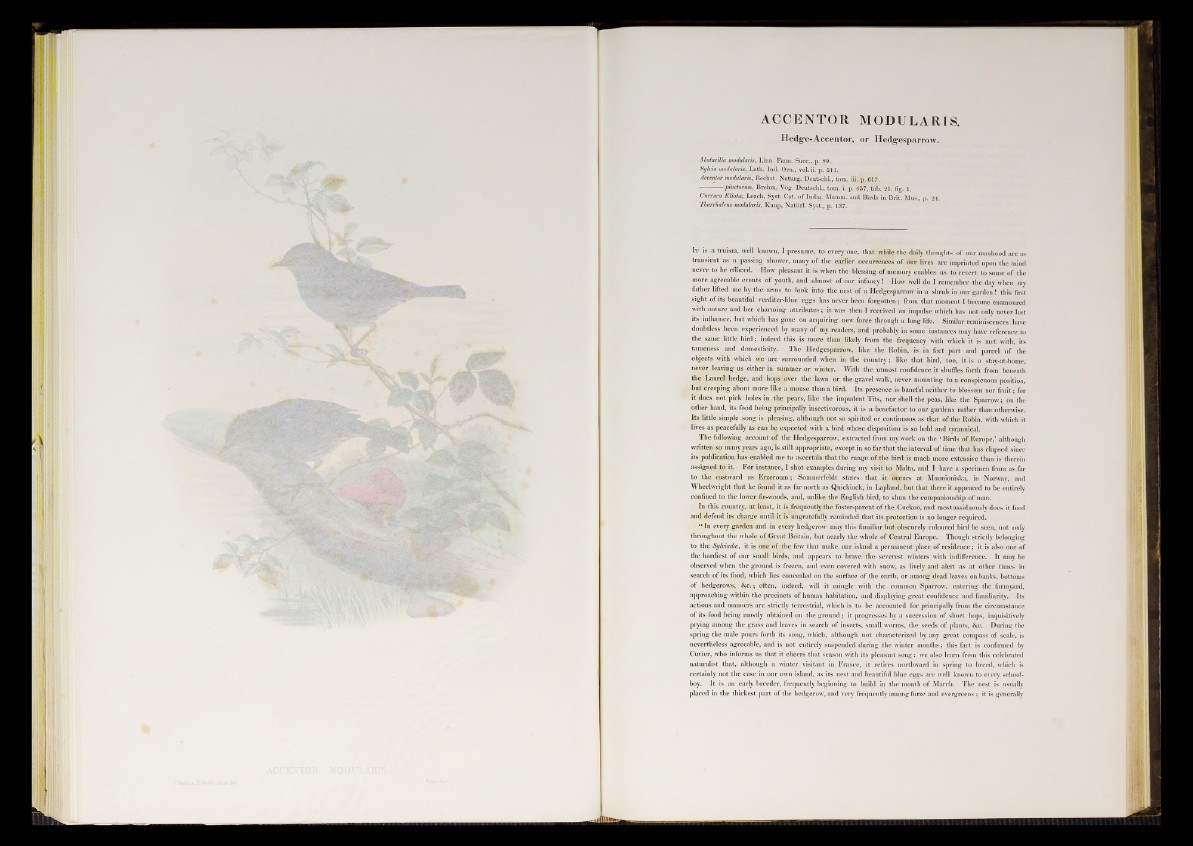
ACCENTOR MODULARIS .
Hedg*e-Accentor, or Hedg*esparrow.
Motacilla modularis, Linn. Faun. Suec., p. 89.
Sylvia modularis, Lath. Ind. Orn., vol.ii. p. 511.
Accentor modularis, Bechst. Naturg. Deutschl., tom. iii. p. 617.
— pinetorum, Brehm, Vog. Deutschl., tom. i. p. 457, tab. 21. fig. 1.
Curruca Eliotce, Leach, Syst. Cat. of Indig. Mamm. and Birds in Brit. Mus., p. 24.
Tharrhaleus modularis, Kaup, Natiirl. Syst., p. 137.
It is a truism, well known, I presume, to every one, that while the daily thoughts of our manhood are as
transient as a passing shower, many of the earlier occurrences of our lives are imprinted upon the mind
never to be effaced. How pleasant it is when the blessing of memory enables us to revert to some of the
more agreeable events of youth, and almost of our infancy! How well do I remember the day when my
father lifted me by the arms to look into the nest of a Hedgesparrow in a shrub in our garden! this first
sight o f its beautiful verditer-blue eggs has never been forgotten; from that moment I became enamoured
with nature and her charming attributes; it was then I received an impulse which has not only never lost
its influence, but which has gone on acquiring new force through a long life. Similar reminiscences have
doubtless been experienced by many of my readers, and probably in some instances may have reference to
the same little bird; indeed this is more than likely from the frequency with which it is met with, its
tameness and domesticity. The Hedgesparrow, like the Robin, is in fact part and parcel of the
objects with which we are surrounded when in the country; like that bird, too, it is a stay-at-home,
never leaving us either in summer or winter. With the utmost confidence it shuffles forth from beneath
the Laurel hedge, and hops over the lawn or the gravel walk, never mounting to a conspicuous position,
but creeping about more like a mouse than a bird. Its presence is baneful neither to blossom nor fru it; for
it does not pick holes in the pears, like the impudent Tits, nor shell the peas, like the Sparrow; on the
other hand, its food being principally insectivorous, it is a benefactor to our gardens rather than otherwise.
Its little simple song is pleasing, although not so spirited or continuous as that of the Robin, with which it
lives as peacefully as can he expected with a bird whose disposition is so bold and tyrannical.
The following account of the Hedgesparrow, extracted from my work on the ‘ Birds of Europe,’ although
written so many years ago, is still appropriate, except in so far that the interval of time that has elapsed since
its publication has enabled me to ascertain that the range of the bird is much more extensive than is therein
assigned to it. For instance, I shot examples during my visit to Malta, and I have a specimen from as far
to the eastward as Erzeroum; Sommerfeldt states that it occurs at Muonioniska, in Norway, and
Wheelwright that he found it as far north as Quickiock, in Lapland, but that there it appeared to be entirely
confined to the lower fir-woods, and, unlike the Euglish bird, to shun the companionship of man.
In this country, at least, it is frequently the foster-parent of the Cuckoo, and most assiduously does it feed
and defend its charge until it is ungratefully reminded that its protection is no longer required.
“ In every garden and in every hedgerow may this familiar but obscurely coloured bird be seen, not only
throughout the whole of Great Britain, but nearly the whole of Central Europe. Though strictly belonging
to the Syleiadte, it is one of the few that make our island a permanent place of residence; it is also one of
the hardiest of our small birds, and appears to brave the severest winters with indifference. It may be
observed when the ground is frozen, and even covered with snow, as lively and alert as at other times in
search of its food, which lies concealed on the surface of the earth, or among dead leaves on banks, bottoms
of hedgerows, &c.; often, indeed, will it mingle with the common Sparrow, entering the farmyard,
approaching within the precincts of human habitation, and displaying great confidence and familiarity. Its
actions and manners are strictly terrestrial, which is to be accounted for principally from the circumstance
of its food being mostly obtained on the ground; it progresses by a succession of short hops, inquisitively
prying among the grass and leaves in search of insects, small worms, the seeds of plants, &c. During the
spring the male pours forth its song, which, although not characterized by any great compass of scale, is
nevertheless agreeable, and is not entirely suspended during the winter months; this fact is confirmed by
Cuvier, who informs us that it cheers that season with its pleasant song: we also learn from this celebrated
naturalist that, although a winter visitant in France, it retires northward in spring to breed, which is
certainly not the case in our own island, as its nest and beautiful blue eggs are well known to every schoolboy.
It is an early breeder, frequently beginning to build in the month of March. The nest is usually
placed in the thickest part of the hedgerow, and very frequently among furze and evergreens ; it is generally